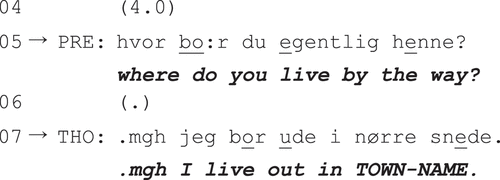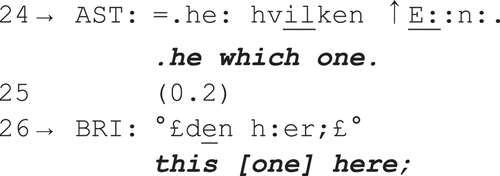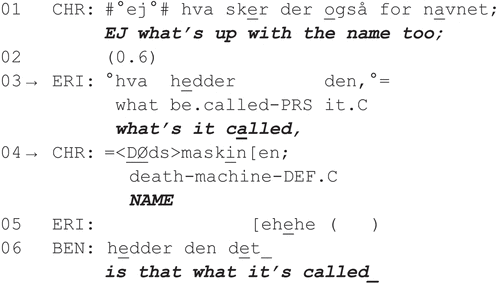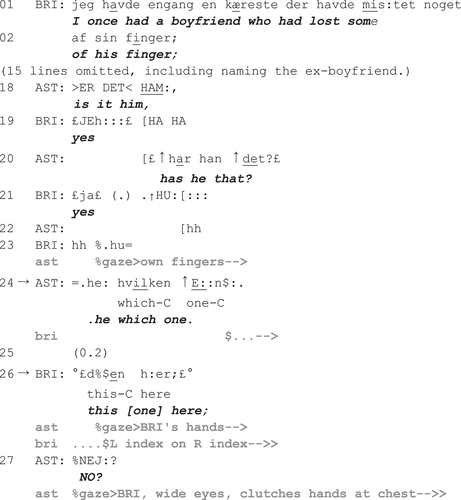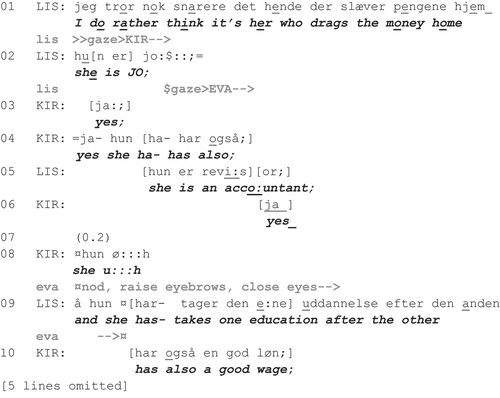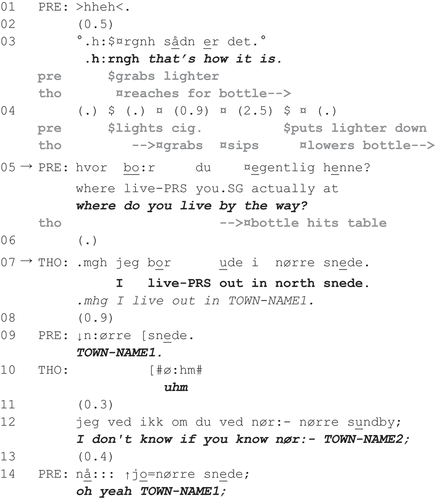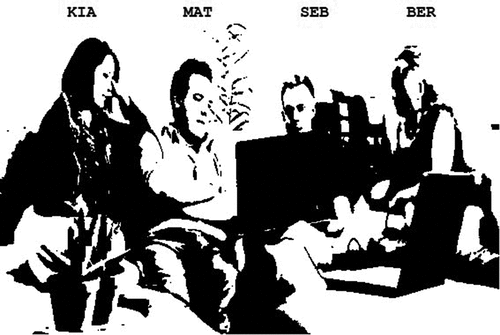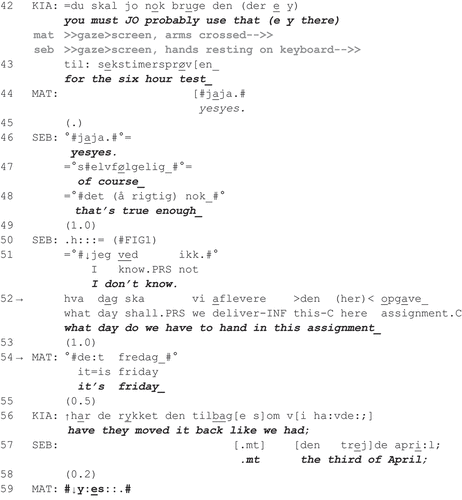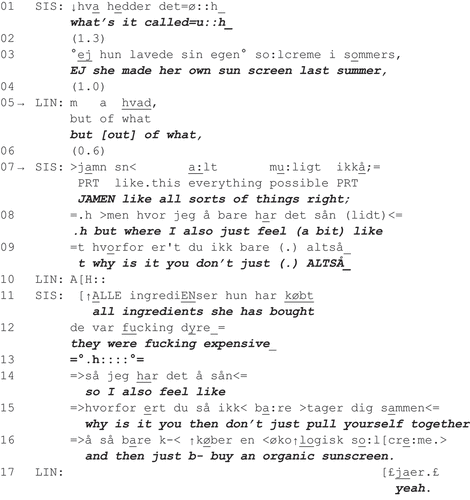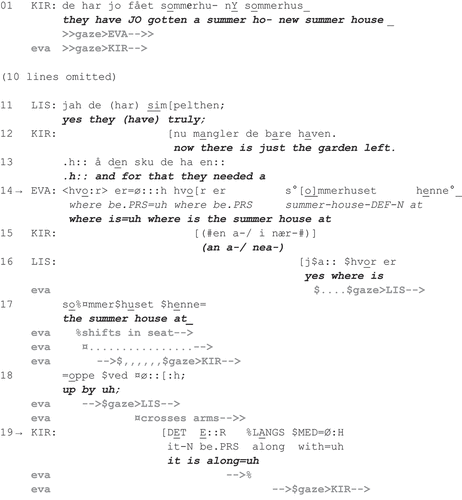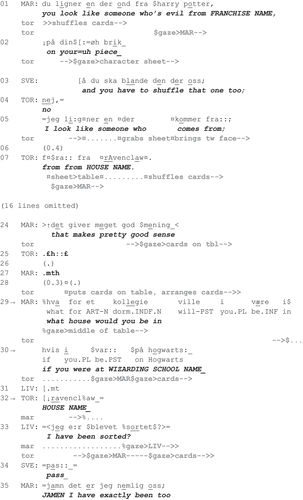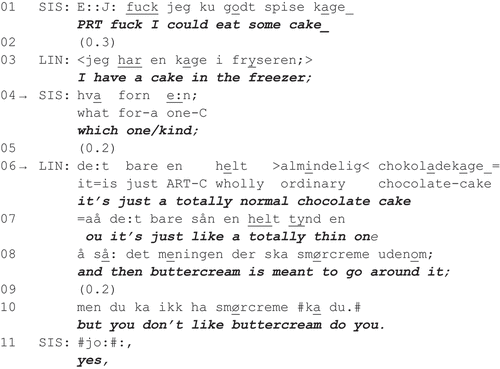ABSTRACT
Some WH-questions (e.g. “Where do you live?”) specify a particular piece of information that would count as an answer. This article is about the differences, in Danish talk-in-interaction, between two kinds of ways of providing that information: in a phrase (e.g. “In Copenhagen”) or in a clause (e.g. “I live in Copenhagen”). I show that phrasal responses align with questions in expansion sequences, orienting to them as part of an ongoing sequence and trajectory, whereas clausal responses align with questions in base sequences, treating them as independent of prior talk and asked with no prior knowledge. The differences between the response formats can be used as resources to claim and manage discrepancies in speakers’ knowledge, or in the trajectory of their talk. The analyses contribute to growing evidence for treating grammar as positionally sensitive, as well as to studies of degrees of minimality and grammatical parasitism. Data are in Danish.
Research in conversation analysis (CA; Sidnell & Stivers, Citation2013) and interactional linguistics (IL; Couper-Kuhlen & Selting, Citation2018) has shown that grammar is positionally sensitive (Schegloff, Citation1996a) in relation to both action formation and ascription (Levinson, Citation2013). This entails that, for turns-at-talk, “we should take seriously the possibility that aspects of their structure—for example, their grammatical structure—are to be understood as adaptations to that environment” (Schegloff, Citation1996a, pp. 54–55).
Much research demonstrating positional sensitivity has been carried out in studies of questions and answers (e.g., Fox & Thompson, Citation2010; Keevallik, Citation2010; Raymond, Robinson et al., Citation2021; Sorjonen, Citation2001; Thompson et al., Citation2015). In their seminal article on the matter, Fox and Thompson (Citation2010) showed that, in American English, WH-questions can be divided into two groups based on the type of response they request. Telling questions request longer stretches of talk, whereas specifying questions request specific pieces of information. For specifying questions, the authors demonstrated how interactional concerns motivate a choice between two different response formats: phrasal responses, found to do simple answering, and clausal responses, which orient to something problematic in the question or sequence. Fox and Thompson (Citation2010) also found quantitative support for the unmarkedness of phrasal responses, as they were the most common in their collection.
The collection this article is based on reveals that interactants also distinguish between phrasal and clausal responses to specifying WH-questions in Danish talk-in-interaction. However, as I will argue, a different interactional logic seems to be at play in the choice between the two. Consider these two initial examples, each showcasing a different format. In the first excerpt, colleagues Preben and Thomas have just closed the previous topic of conversation. After a lapse (l. 4), Preben launches a new topic with a specifying question in l. 5, asking where Thomas lives.
(1) Nørre Snede – excerpt (TalkBank | Preben&Thomas | 29:50)
In line 7, Thomas responds clausally, delivering the requested information.
In the next example, teenage girls Astrid and Britt are chatting about an ex-boyfriend of Britt’s. Britt has just disclosed that the ex was missing part of a finger. This makes both girls laugh, and prompts Astrid to ask follow-up questions, among which is the specifying question in line 24.
(2) Finger – excerpt (AULing | Sofasladder | 05:20)
Britt responds with the requested information in a phrasal format in line 26. I return to both examples in depth in later sections, but for now, notice that both responses seem unproblematic. Both are delivered almost immediately and do not include particular features in their design that orient to issues with the question or sequence.
In the collection on which this article is based, clausal responses are found to be the most common, with 58 clausal responses to 40 phrasal. Even when disregarding unrelated clausal responses (i.e., clausal responses that do not reuse any lexical material from the preceding question; Thompson et al., Citation2015) and responses that show no access (Raymond, Citation2003) or no knowledge—for example, det ved jeg ikke (“I don’t know”), most of which are clausal, the amount of phrasal and clausal responses is almost equal, with 35 clausal and 39 phrasal responses remaining.
These numbers, as well as the apparent nonproblematicity of either response type, suggest that a different interactional logic might be at play in responses to specifying questions in Danish compared to American English. In this article, I attempt to fill the knowledge gap this presents, asking the following research questions: (1) What interactional logic motivates the choice between clausal and phrasal responses to specifying questions in Danish? (2) What do interactants accomplish by using one format over the other?
Returning to the two excerpts above, we might note that Astrid’s question comes as part of a larger sequence of follow-up questions that serve to develop an ongoing trajectory. This question receives a more minimal (e.g., Thompson et al., Citation2015) response. Preben’s question instead initiates a new topic and base sequence (Schegloff, Citation2007), independent of what has gone before. His question receives a less minimal (Thompson et al., Citation2015) response. This echoes observations from research into more and less minimal forms. Across practices and languages, more minimal forms have been shown to index higher sequential embeddedness and dependency on previous talk, whereas less minimal forms index more independence.
For example, Fox (Citation1987) showed that full names are “resources for designing a turn to be understood as beginning a sequence” (Couper-Kuhlen & Selting, Citation2018, p. 335), whereas pronouns are used to show “non-firstness,” that is, the continuation of a sequence and course of action (Fox, Citation1987). Full names can be called locally initial forms, whereas pronouns are locally subsequent (Schegloff, Citation1996b). Levinson (Citation1983, pp. 356–364) showed how the introduction of certain things in pre-sequences (Schegloff, Citation2007) allow for “truncated” base sequences. For Estonian, Keevallik (Citation2010) showed that minimal particle responses to polar questions treat the sequential status of the question as “non-primary”—that is, as occurring in an expansion sequence (Schegloff, Citation2007) embedded within a trajectory—whereas less minimal verb repeat responses orient to the question as a “primary” action—that is, occurring in a new base sequence. In their article on the offer and request formats do you wanna, you wanna and wanna, Raymond, Robinson, et al. (Citation2021, 82 ff.) showed that more minimal forms are used when interactants have displayed a disposition to accept an offer, whereas the less minimal are used when they have not. They suggested “grammatical parasitism” as a possible explanation for this phenomenon, the concept that more minimal forms “accomplish a stronger sense of dependency on prior talk” (2021, 83).
In this article, I argue that a similar explanation can account for the distribution and interactional differences of phrasal and clausal responses to specifying questions in Danish. Phrasal responses orient to and align with specifying questions that are parts of larger sequences and trajectories of talk, where there is shared knowledge in the common ground (Clark, Citation1996). The phrasal responses index sequential embeddedness (e.g., Fox, Citation2007, p. 305) and thus align with questions that rely heavily on previous talk. Clausal responses, on the other hand, are used to orient to specifying questions that are opening new base sequences and trajectories, where there is no knowledge in the common ground. Clausal responses index independence and are thus able to align with questions that themselves are independent.
One type of evidence for my claim is distributional. The two formats have particular sequential contexts in which they typically occur, with phrasal responses occurring in expansion sequences and clausal responses occurring in base sequences. However, their distribution is not deterministic, and they can and do occur outside of their home environments. In these cases, they do so “for cause,” retaining the interactional properties form their home environments. These cases give my claim further support and will be considered in this article as well.
The structure of the article is as follows: In the next section, I present my method and data. Then I analyze representative examples of phrasal and clausal responses in their sequential home environments, showing their interactional implications. In the fourth section, I show four cases in which these implications are used as resources in managing knowledge and the trajectory of talk, including two cases in which the formats occur outside their home environments. The final sections offer discussion and conclusions.
Data and method
This article is based on a collection analysis of 98 responses to specifying questions found in 18 video recorded conversations, totaling 7 hours and 47 minutes of recorded material. Data stem from two corpora of naturally occurring Danish interaction: the AULing corpus, hosted at Linguistics, Aarhus University (Samtalegrammatik.dk, Citation2024), and TalkBank’s publicly available Danish corpus, SamtaleBank (MacWhinney & Wagner, Citation2010). Both corpora contain different types of conversations. For this study, I specifically chose noninstitutional data, focusing on video-recorded face-to-face interactions to be able to take embodied conduct into account when relevant. The participants in the recordings are all L1 speakers of Danish. They have given their informed consent to being recorded, and all are anonymized.
I used next turn proof procedure to identify questions in the collection process (cf., Couper-Kuhlen & Selting, Citation2018, pp. 217–218): If a turn was treated as requesting information by participants, I regarded it as a question. My collection thus contains cases of other-initiated repair that request information. Cases of repair following open class repair initiation (Drew, Citation1997) have not been included. I used next turn proof and my native speaker intuition to determine if the questions were specifying questions—that is, if they request specific pieces of information rather than tellings.
Phrasal responses in the collection can be single lexical items or larger phrases, for example, noun phrases containing determiners and other modifiers. Clausal responses contain at least a subject and a verb and, unless the requested piece of information is the subject, a phrase with the information. Clausal responses can be single or multi-clause units. Both phrasal and clausal responses can contain particles such as øh(m) (“uh(m)”), markers of approximation, and markers of epistemic (un)certainty (e.g., tror jeg [“I think”], compare Fox & Thompson, Citation2010, p. 143).
Apart from responses that supply the requested information, the collection also contains examples of no-access responses (e.g., Raymond, Citation2003), such as jeg ved det ikke (“I don’t know”), and so-called unrelated clausal responses (Thompson et al., Citation2015, p. 32) that do not repeat lexical material from the question, thus “resist[ing] the grammatical relevancies mobilized by the question” (Thompson et al., Citation2015, p. 32) in a similar way to transformative responses (Stivers & Hayashi, Citation2010). The responses in the collection are represented in .
Table 1. Overview of collection.
No-access responses and unrelated clausal responses were analyzed by Fox and Thompson (Citation2010) and Thompson et al. (Citation2015), which is why they were included in the collection and are represented in the table. However, both response types fundamentally perform different actions than responses providing specific information: Unrelated clausal responses are used to resist some terms of the question. No-access responses are highly formulaicFootnote1 and not particular to specifying questions, as they are used across question types, including as responses to polar questions. These two response types will therefore not be considered further in this article.
My method is conversation analysis (CA; Sidnell & Stivers, Citation2013) and interactional linguistics (IL; Couper-Kuhlen & Selting, Citation2018). My transcriptions follow the conventions in Hepburn and Bolden (Citation2013), with the addition of the semicolon for slightly falling final intonation. I use Mondada’s (Citation2018) conventions for multimodal transcription when relevant, as well as Leipzig glossing (Comrie et al., Citation2015) of all target lines (questions and responses).
Phrasal and clausal responses in their sequential home environments
In the following sections I will present the interactional motivations of phrasal and clausal response formats in detail. As mentioned, one type of evidence for the interactional difference between them is distributional: The two formats have a strong tendency to occur in different environments. These environments vary based on the status of the sequence (Keevallik, Citation2010; Schegloff, Citation2007), the amount of knowledge in the common ground (Clark, Citation1996), and the position of the response and its question in larger ongoing courses of action. I provide representative examples of these environments and aim to show that, when in their respective home environments, the two response formats are both aligning and unproblematic.
Phrasal responses indexing embeddedness
In my collection, phrasal responses typically occur in expansion sequences—specifically insert and post-sequences (Schegloff, Citation2007)—and in longer sequences connected to story-tellings, news, and announcements (big packages; e.g., Couper-Kuhlen & Selting, Citation2018). Specifying questions that receive phrasal responses in these environments orient to the need to carry on ongoing trajectories and courses of action, as well as to the fact that a certain amount of shared knowledge is in the common ground. The following three examples are representative of these sequential environments and phrasal responses’ role in them.
In Example 3, four teenage boys are discussing Ungdomshuset (“The Youth House”), an anarchic, self-governing youth club that, at the point of recording, had recently been forcefully relocated. The boys are assessing the new place negatively and have now turned to discuss the club’s in-house café and concert venue, the name of which Christian assesses in line 1.
(3) Dødsmaskinen (TalkBank | Fyrene | 03:06)
Christian’s assessment is formatted as a rhetorical question that leaves the venue’s name out but shows negative disbelief toward it with hva sker der (“what’s up with”). He connects his assessment to the ongoing negative sentiment with også (“also”), which, combined with leaving out the name, suggests that he projects the others to be able to readily deliver affiliating, equally negative second assessments. However, this does not happen. After a beat of silence, Erik quietly initiates repair with a specifying question in line 3, requesting the name of the venue and opening an insert sequence. Christian immediately provides the name in a phrasal response—“the Death Machine”—pronouncing the first syllable døds (“death”) loudly, slowly, and with emphasis, marking it as what is particularly assessable about the name. Erik orients to this by laughing before the response is even completed.
Erik’s question is positioned in an insert sequence, embedded within the larger assessment sequence. The specifying question is not used to launch new trajectories of talk but, instead, to request repair in service of an already ongoing course of action: What Erik requests is the exact piece of information missing in the original assessment that will allow the interactants to bring the sequence to its projected outcome.
Christian’s immediate response completes the insert sequence in a minimal format, parasitic on previous talk. It is afforded by, and relies on, the topic and referent being established (cf., Fox, Citation2007) and in the common ground (Clark, Citation1996), and because it completes the insert sequence, it is also itself sequentially embedded within the trajectory. By providing a minimal response, Christian treats the question as requesting only a minimal operation: All that is needed is the requested piece of information. This will bring the larger sequence closer to its projected outcome. The response thus orients to the question as continuing an ongoing course of action, and the response itself also works to continue this trajectory: It allows Christian to prosodically highlight the assessable early in his response, carrying on his negative affective stance and enabling an eventual second assessment. The response can be said to align with the question, and it is treated as sufficient, understandable, and unproblematic, allowing the sequence to reach its projected outcome: In line 5, Erik laughs, providing both a receipt for the repair and an affiliative assessment. Benjamin asks for a reconfirmation (line 6), showing ritualized disbelief and thus also furthering the negative assessment.
Next, here is the full version of Example 2 from the introduction. Teenage girls Astrid and Britt are chatting on a sofa at their school. Following a story from Astrid about her boyfriend’s finger sticking out from his hand in a way Astrid found unappealing (not shown), Britt launches a potential second story with a similar theme, stressing where it differs: This boyfriend had mistet (“lost”) part of a finger (line 01). After some initial laughter and assessments, Astrid asks for the name of the ex (lines 3–17, omitted). It turns out she knows him.
(4) Finger – full (AULing | Sofasladder | 05:20)
The discovery that Astrid knows the ex-boyfriend prompts a series of expanding follow-up questions, creating an interview-like sequence with Astrid as the questioner.Footnote2 The first question (line 18) asks Britt to reconfirm the ex-boyfriend’s identity while conveying Astrid’s recognition and surprise. The second is a proform-question copy of the original informing (Jørgensen, Citation2024; Steensig et al., Citation2023), bringing talk back to the content of line 1 and marking the information that the ex has lost part of a finger as surprising and counter to Astrid’s previous knowledge (ibid.). The present tense form of the verb har (“has”) indicates that Astrid now treats the story more like a news telling sequence. All the questions are rely on what is established and are thus locally subsequent (cf., Schegloff, Citation1996b).
With the initial informing now made relevant again, Astrid asks another expanding follow-up question, a phrasal specifying hvilken ↑E::n (“which one”) while looking at her hands, fingers spread out (lines 23–26). This question is also embedded within the current trajectory. Its design relies on the initial informing (line 1) and the informing’s proform copy (line 20): Astrid only needs to use a question word asking for member of a group (“which”), a locally subsequent anaphoric reference, en (“one”), and a gaze at her fingers to ask which of the boyfriend’s fingers was missing a piece. Astrid thus treats the information in line 1 as in the common ground. The question requests a very particular piece of information that expands on this original informing, working toward developing the ongoing project rather than starting something new.
Britt begins an embodied part of her response—a point to her left index finger—before the question is complete, thus treating the question as both relevant and understandable. The verbal component of her response, a phrasal den her (“this [one] here”), is as embedded within the sequence as the question. It treats the question as requesting a minimal operation; this is all that is needed to further the ongoing trajectory and the interview-like format it has taken. Its grammatically parasitic format helps it orient to the question as embedded within the sequence and as part of a larger, ongoing trajectory: Both question and response are locally subsequent.
Astrid treats the response as relevant and appropriate, receipting it with an affective NEJ:? (“no”), which, together with widened eyes and clutched hands, displays a continuation of her surprised and shocked affective stance. She then continues her questioner role, asking further expanding follow-up questions (not shown).
Phrasal responses’ reliance on established information seems, in certain circumstances, to allow them to refer to common ground beyond the immediately preceding talk. In the example below, three elderly ladies are talking about a couple they know who have done well for themselves financially. Eva suggests the husband’s high wage as the reason (omitted). Gazing at Kirsten, Lis counters this by suggesting that it is instead the wife who brings home the money (line 01). Kirsten agrees (line 3). Then, Lis, still gazing at Kirsten, starts an account for her counter (line 02) with jo to suggest shared knowledge (cf. Heinemann et al., Citation2011). Midway through jo, she shifts her gaze to Eva and restarts her utterance without jo, thus designing her account as news to Eva (line 5). Eva receipts it as such with a nod and raised eyebrows (lines 8–9). After the account is complete (omitted), Eva produces a final confirmation token (line 16). Kirsten then opens a post-expansion sequence, asking for the wife’s job title (line 17).
(5) Revisor (TalkBank | OmFodbold | 01:56)
The format hva er:t hun er (“what is it she is/does”)—as contrasted with hva er hun (“what is she”)—is routinely used to mark the information requested as something known, but currently forgotten (Hamann & Nielsen, Citation2022). Thus, Kirsten does not ask for repair because of, for example, a problem of hearing, but specifically because of a problem of remembering. Indeed, Kirsten is engaged in independently asserting her knowledge of the wife’s wage in overlapping talk (lines 4, l. 6, l. 8, l. 10) as Lis mentions her occupation, and she seems to not have heard it mentioned.
The question’s sequential position, format, and use of the pronoun “she” points to its relation to the ongoing trajectory. Kirsten opens the post-expansion to solve her issue of remembrance, which will allow for satisfactory sequence closure. Lis’s response orients to this. It is immediate and minimal, orienting to Kirsten’s question as requesting nothing but the name of the profession. In receipt of the response, Kirsten immediately unfurrows her brow and turns her head away in a big nod as though hearing something obvious, and in line 19, she produces a deeper, falling repeat of the response, hearable as registering it as now remembered (cf., Nissen, Citation2015). She then adds a “yes that’s right,” showing definitively that she already knew this information. Kirsten’s orientation to Lis’s response thus points to the response as both acceptable and appropriate, but also specifically as something that repairs a problem of remembering by referring to shared information between the two ladies.
In this example, we thus again see a phrasal response treat a question as embedded in—and asked in service of—an ongoing trajectory. Additionally, Kirsten and Lis’s orientations show an epistemic dimension to this particular question-response sequence, appealing to shared knowledge beyond the prior talk.
To summarize, phrasal responses most often occur in expansion and follow-up question sequences; these can be called their sequential home environments. Here, they respond to questions that are sequentially embedded, continuing, and aiding an ongoing course of action by requesting just the minimal information needed for the trajectory to continue. The responses align with the sequential embeddedness of the questions, treat them as requesting minimal operations, and orient to a certain amount of established information between the participants. Their phrasal, grammatically parasitic format seems well-suited to perform these tasks.
Clausal responses indexing independence
In contrast to phrasal responses, clausal responses in my collection typically occur in base sequences (Schegloff, Citation2007), most of which introduce new topics or trajectories of talk. Specifying questions in these environments not only request specific pieces of information but also mark the beginning of something new and independent from previous talk, as well as a lack of established knowledge and common ground (Clark, Citation1996) between the participants. The clausal responses seem to orient to this. The two examples below are representative of these environments and clausal responses’ role in them.
Below is the full version of Example 1 from the introduction. Colleagues Preben and Thomas are chatting, smoking, and drinking beer. Preben closes the previous topic of talk with a single laughter token and a general closing remark, sådn er det (“that’s how it is,” lines 1–3). Then, a four-second lapse follows, in which Preben lights a cigarette and Thomas takes a sip of beer (line 4). In line 5, Preben initiates a new base sequence, proposing a new topic with a WH-question. The question is specifying, as it requests a specific piece of information, for example, a town or street name.
(6) Nørre Snede – full (TalkBank | Preben&Thomas | 29:50)
Thomas’s response to the question is clausal, containing both a subject, a verb, and a prepositional phrase with the requested information. He delivers the response as soon as possible, right after he has swallowed his beer (the swallowing produces the .mgh at the beginning of line 7).
Preben’s specifying question initiates a new base sequence. Not only is it separated from previous talk by the sequence closing remarks and the lapse, but the question is designed with the adverb egentlig (“actually, by the way”), which works as a misplacement marker (cf., Clift, Citation2001). Apart from detaching the question from the preceding talk, it marks the requested information as something Preben has no prior knowledge about. The question’s position and design makes it hearable as not only requesting a specific piece of information, but also as initiating a new course of action: It acts as a topic proffer. Additionally, the exact form that the piece of information requested is still up in the air at this point. Several things could be relevant, such as a town name, street name, or full address. It will be up to Thomas, who is the epistemic authority on this matter, to deliver the most relevant piece of information.
Thomas delivers his response as soon as possible. Although his response is not completely independent of the question, as it recycles the question’s verb and subject (adjusted for deixis), it does constitute a less grammatically parasitic format (Raymond, Robinson et al., Citation2021) compared to a phrasal response. In principle, the turn is understandable in itself. This higher degree of independence allows Thomas not just to deliver the requested information but also to show some agency in accepting the new proposed topic, and to mark his epistemic primacy on it (cf., Heritage & Raymond, Citation2005). He thus orients to both the aspect of the question that requests information, and to the aspect that it starts something new and independent, and perhaps in particular that it starts new topic talk to be further developed.
Preben initially has difficulty locating the town and asks for repair by repeating the name in line 9. Thomas provides it by mentioning another nearby town, and Preben then shows now-remembrance in line 14, orienting to the town name as familiar to him. After this, topic talk on Thomas’s hometown continues unproblematically.
This is a typical sequential environment for clausal responses in my collection. With their less minimal format and lower degree of grammatical parasitism, they seem able to attend to questions that initiate new trajectories. The following example provides another instance of a clausal response following a question that is separate from what has gone before. A group of four students are working on an assignment. They sit on a sofa, with Sebastian holding a laptop with the assignment on it in his lap (see ).
Throughout the recording, the students mostly procrastinate. About 25 minutes into the recording (a moment before the extract below), Sebastian declares that he does not want to work on their assignment anymore. The talk then moves on to other assignments and tests. In lines 42–43, Kia-Klara argues that the group needs to use a particular method or model for an upcoming test. Mathias and Sebastian agree (lines 44, 46), and Sebastian then repeats his agreement in two new, reformulated turn construction units (lines 47–48), signaling a move toward sequence closure. Neither Sebastian nor Mathias look at Kia-Klara; both are gazing at the computer screen (see ).
(7) Fredag (TalkBank | studiegruppe | 24:55)
In line 52, Sebastian asks a specifying question, requesting the deadline date for the group’s current assignment. Nothing in the question suggests that he knows when this deadline could be, and the group has not discussed the deadline before this excerpt. Most likely, there is no common ground shared on this between the interactants.
The (re-)introduction of the assignment with a full noun phrase (“this (here) assignment”) makes the question hearable as not being occasioned by immediately preceding talk, but as presenting a different topic (Raymond, Clift et al., Citation2021, p. 734). Sequentially, the question comes after Sebastian’s move toward sequence closure (line 46–48), a beat of silence (line 49), and a hearable inbreath (line 50) that leads to a low, quiet, and creaky jeg ved ikk (“I don’t know,” line 51). This might orient to the ongoing topic shift (e.g., Maschler, Citation2017, p. 53) or index a frustrated affective stance, drawing threads back to Sebastian’s wish of quitting the assignment for the day. All in all, Sebastian’s question opens a new base sequence and trajectory, moving away from the immediately preceding topic.
Mathias’s response is quite delayed, but this seems connected to the fact that Mathias’s and Sebastian’s attention is split between their interaction and the computer screen. Similarly, Sebastian’s reaction to Mathias’s eventual response comes relatively late, and this is seemingly not problematic. The response is a minimal clause, de:t fredag (“it’s Friday”), with the realization of the copula as a prolonged e: in de:t being the normal version of “it’s” in Danish (e.g., Kragelund, Citation2015). Even if Mathias’s response is relatively minimal, it is distinctly hearable as a clause with its own subject and verb, and as such constitutes a less minimal, more independent response when compared to phasal responses. It comes in a typical position for clausal responses. In this position it might be relevant not just to provide information but also to orient to the initiation of a new, independent sequence and trajectory, and to the fact that the questioner is asking from a position of no knowledge. The response might allow Mathias to at least attend minimally to these aspects of the question, align with its independence and position himself with epistemic primacy, something his confident “yes” in line 59 supports.
To summarize, clausal responses’ sequential home environments are base sequences, and they often follow questions that change the trajectory of talk. Clausal responses constitute a format that is less grammatically parasitic on previous talk. Using this format in these sequences allows interactants to attend to the question as starting a new course of action, sequentially detached from what has gone on before. Clausal responses orient to the newness of both the trajectory and the information, in a way that shows that no information is established yet between the interactants.
Managing knowledge and the trajectory of talk with phrasal and clausal responses
As mentioned, one type of evidence for the interactional implications of each of the response formats described above is their distribution. They strongly tend to occur in different sequential environments, varying based on the status of the sequence, whether a new trajectory is initiated by the question, and the degree of knowledge in the common ground (Clark, Citation1996). In their home environments, the response formats are routinely treated as unproblematic. However, there are also cases in which the response formats are used to attend to different issues or achieve particular interactional effects, thanks to their interactional implications; these cases provide further evidence for these implications. In some cases, this happens in their home environments. Here, the combination of the content of the response and its format is used to attend to problematic questions and manage the trajectory of talk. Even more illustrative, however, are those cases in which the response formats occur outside their usual home environments. They can be seen to do so “for cause,” retaining the interactional implications from their home environments to manage aspects of knowledge and the trajectory of talk. In this section, I consider four different examples of responses used to deal with issues or achieve particular effects.
In the first example, a phrasal response is used to deal with a proposed direction for the talk in favor of another. This phrasal response does occur in its home environment, but combined with the nonspecific content of the phrase, it makes a delicate move to a different trajectory possible. Sisse is dyeing Lina’s hair and talking about the girlfriend of a common acquaintance of theirs, who Sisse assesses as annoying. However, as Lina does not know the girlfriend well, Sisse attempts to float her as a referent by referencing a story she has previously told Lina: This is the girl who made her own sunscreen (not shown). Lina does not show recognition, and after a brief intermission in which Sisse notices something in Lina’s hair, she returns to the sunscreen story (lines 1–3).
(8) Solcreme (AULing | haarfarvning1 | 09:39)
When Sisse reintroduces the story (line 03), it is designed as news rather than as something Lina is supposed to remember. Then, silence follows, in which Sisse does not expand. For Lina, Sisse’s project might not be entirely clear. Sisse was assessing the girlfriend negatively, but she does not produce a clear negative assessable in line 3. Lina finally asks, “but out of what” (line 05), stressing “but” and “what” to give the question an air of skepticism toward the potential ingredients. With the grammatically parasitic design, Lina positions the question as sequentially embedded within the assessment trajectory, asking Sisse to supply, for example, a list of ingredients to continue the assessment sequence. However, as it turns out, what Sisse was projecting as the negative assessable was instead the girlfriend’s attitude (line 8) and the fact that she made a sunscreen at all (lines 15–16).
Sisse’s response takes a grammatically parasitic, phrasal format, aligning with the question’s sequential embeddedness. However, the response also orients to something problematic. The turn-initial jamen (“well, yes but”) marks something in the question or response as problematic or nonstraightforward (Pedersen, Citation2015). The response proper is a general alt muligt (“all sorts of things”), preceded by a sn, (“like”), which is used before nominal referents to appeal to shared knowledge (Pedersen, Citation2014). Although the response doesn’t deliver what Lina asked for, it is designed in a way that sequentially aligns with her question and appeals to shared knowledge, effectively treating the question as understandably occasioned, but at the same time treats the response as both obvious and irrelevant for the projected trajectory: Of course, it took a lot of odd ingredients to make the sunscreen, but that is beside the point.
The final particle, ikkå (“right”), further appeals to shared knowledge, but might also be helping Sisse retain the floor (Jensen et al., Citation2019): She immediately latches on a fast-spoken “but”-initiated turn, designed to introduce the relevant assessable. As soon as this project becomes clear, Lina shows recognition of it with a loud laughter particle (line 10), and later with an agreeing “yeah” (line 17). Thus, by dealing with the problem Lina’s question poses—an irrelevant direction for the talk—with a phrasal response containing nonspecific information, Sisse is able to perform a notable but delicate operation to get the topic back on track, away from the direction projected by Lina’s question.
In the second example, a clausal response is used to claim independence, agency, and epistemic primacy (cf., Heritage & Raymond, Citation2005; Raymond, Clift, et al., Citation2021) in a sequence in which two interactants compete about rights to know and tell certain information. Kirsten, Lis, and Eva are discussing a young couple they know (cf. example 5). Kirsten informs Eva that the couple has bought a summer house (line 1), explaining how they have fixed it up (omitted). Lis claims independent knowledge of these efforts (line 11), possibly attempting to take over the storytelling. However, Kirsten continues in line 12. In line 13, as Kirsten draws out en:: (“a”), Eva takes the opportunity to ask a specifying question, requesting the specific location of the summer house.
(9) Sommerhus (AULing | omfodbold | 01:04)
When Kirsten continues building on her previous turn instead of orienting to Eva’s question, Lis restates it (lines 16–17), thus claiming it for herself, then begins responding to it (line 18).
By claiming the question and the opportunity to respond, and by stating her own independent knowledge in line 11 with the intensifier simpelthen (“truly, absolutely”), Lis competes with Kirsten for the right to know and talk about the summer house. Both Eva and Kirsten orient to this as Lis is attempting to usurp the storyteller position. Eva looks briefly at Lis as she starts to speak, then shifts in her seat, starts to cross her arms and looks back at Kirsten (lines 16–17). As Lis continues, Eva shifts her gaze back to her, but keeps her arms crossed. After a moment, Kirsten puts in her own claim for the right to be the storyteller. She produces a clausal response, copying the question’s verb and subject in a pronominal format (“it is”), thus relating her response to the question, but giving it some independence. The response is loud, and it potentially contains an embedded correction (Jefferson, Citation1987) of Lis’s oppe ved (“up by”) to langs med (“along”). The clausal format might be affording this embedded correction. However, what is highlighted in the response is not the correction but the stressed subject, stressed, elongated verb, and the words Haderslev Fjord that follow the øhm.
Both the loudness and the potential correction, along with the response formats’ grammatically more independent format, help Kirsten to claim knowledge and storyteller rights, pushing back against Lis. Lis, however, does not give up; she disregards Kirsten’s contribution, and in line 21 continues building on what she started in lines 17–18, repeating oppe ved. Eva orients to Kirsten’s response as having responded informatively and appropriately to the question, overlapping Lis’s continuation with not just one but three stressed receipts while nodding in line 22.
Kirsten’s more independent, less minimal clausal response is instrumental in claiming agency and ownership of both the knowledge and the storyteller role in the epistemic competition she engages in with Lis (cf., Heritage & Raymond, Citation2005). Eva orients to this with her many receipts.
In the next two examples, the responses in focus occur outside their sequential home environments. First, a question initiating a new base sequence—typically the home environment for clausal responses—receives a phrasal response. It is used to achieve a nonengaging effect and appeal to common ground. Four friends are setting up a role-play board game. Each is given a character sheet and a brik (“piece, man”), both with drawings of their character. While both Margrethe and Torsten are shuffling cards, Margrethe assesses Torsten’s character as looking “like someone who’s evil from Harry Potter” (lines 01–02). Torsten looks at the drawing on his character sheet (line 02) while Sven places another stack of cards on front of him (line 03). Still examining the drawing, he accepts Margrethe’s Harry Potter premise, but counters her assessment with a “no” (line 4) and the assessment that his character looks like someone “from Ravenclaw” (lines 05–07), one of the houses at Harry Potter’s school, Hogwarts.
(10) Ravenclaw (AULing | boardgamecoffee3 | 36)
Torsten’s counter is very particular and reveals his knowledge of the Harry Potter universe: He counters the general “someone who’s evil” with a specific and arguably quite niche element of the universe. He also reveals knowledge by orienting to looking like someone from Ravenclaw as a suitable counter to looking evil.
Margrethe doubles down on her initial assessment (omitted). After some teasing and laughter continuing the Harry Potter thread, but with no further mention of Hogwarts houses (omitted), the two reach an accord (line 24). After a beat of silence, Margrethe asks a specifying question (lines 29–30). Although thematically connected to the previous talk, this launches a new base sequence, changes the project from joking or teasing to more genuine inquiry, and changes the participant framework by inviting everyone to respond.
Liv and Torsten begin responsive turns simultaneously (lines 31–32), but Torsten is the first to deliver an actual response, a phrasal “Ravenclaw.” Liv delivers an unrelated clause—that is, a response that does not reuse any lexical items from the question (Thompson et al., Citation2015; cf., Data and method). This goes on to set up her actual later response (“Slytherin”). Sven delivers a no-access (Raymond, Citation2003) response (line 34).
Liv’s turn (line 33) is of a type not otherwise considered in this article, as it does not deliver the requested information (cf., Data and method). It is worth noting, however, that her response does orient relevantly to the question, and specifically as introducing a new topic of talk to be developed. She shows her knowledge of and engagement with the in-universe process of finding her house and uses the unrelated clausal response to make more talk about it relevant. Margrethe orients to it as a relevant contribution (line 35) and asks for Liv’s house (omitted). Talk about houses continues for a while, with Liv, Margrethe, and Torsten participating (omitted).
By contrast, Torsten’s phrasal response treats the question as requiring only a minimal operation. His arranging of the cards on the table could be one explanation for this minimality. However, he is not so engaged in this that he cannot glance at Margrethe as she asks her question (lines 29–30), respond immediately, then glance at her again after his response (line 33). Another explanation might be that Torsten is trying to get his response in ahead of the others’. Although this allows him to deliver a clear response immediately, the minimal format does not engage with the topic initiating aspect of the question. Instead, Torsten’s response treats the name of the house as all that is relevant to orient to for him. In addition, his deep, flat delivery makes the response sound certain and matter-of-fact. As Torsten delivers the response, he looks at the cards he is arranging on the table, away from the other interactants, demonstrating disengagement and no intention to say more. This does not seem to show disinterest, as Torsten does look at Margrethe in line 33, possibly trying to glean a reaction. Rather, it underlines the matter-of-factness of the response and the nonengagement of the response in the topic initiating aspect of the question.
All in all, Torsten’s phrasal response and its prosodic and embodied delivery makes the fact he is a Ravenclaw sound both certain, perhaps even obvious, and not up for further discussion. This is one effect the phrasal response achieves. At the same time, Torsten is on record as having mentioned Ravenclaw earlier, unprompted; among many possible, relevant counters to Margrethes assessment, this was the one he chose. He is also on record as identifying his board game character as looking like someone from Ravenclaw. His minimal, more parasitic response might be allowing him to create a sense of embeddedness, a connection to the previous sequence, showing retroactively that, while his counter in line 5–7 was said in a joking context, it was motivated by his own understanding of where he would belong in the Harry Potter universe. If so, he orients to his response as already in the common ground, effectively reframing his earlier mention of Ravenclaw as not just about his character but about himself.
The phrasal response would thus function as it does in its home environment. It orients to the question as requesting a minimal operation and not as opening a new topic of talk, making it sound matter-of-fact. Furthermore, it creates a sense of embeddedness, relying on, and implying, shared knowledge. The phrasal response might thus be occurring here “for cause.”
Finally, here is an example of a clausal response occurring outside of its home environment “for cause,” here, to break out of a trajectory that has turned problematic and instead start a new one. Sisse has been dyeing Lina’s hair, and the girls now wait for the dye to dry. While waiting, they chat and scroll through social media on their phones. Sisse finds a picture of a chocolate cake and shows it to Lina, saying she could eat some cake (line 1). This prompts Lina, whose home they are in, to tell Sisse that she has cake in the freezer.
(11) Kage (AULing | haarfarvning2 | 07:45)
Sisse, treating Lina’s informing in line 3 as a potential offer, launches an insert sequence meant to clear up what kind of cake it is so she can decide if she should accept the offer or not (line 4). The question is a specifying, phrasal question, grammatically relying on Lina’s informing and requesting specific information that expands on it. This is a typical environment for phrasal responses. Lina, however, seems to only now remember a condition that will make her offer invalid. The cake is supposed to be covered in buttercream (line 8) to be interesting, but as far as she knows, Sisse does not like buttercream (line 10).
The issue in the sequence is in the premise of the offer—namely, that the cake in the freezer would be suitable for Sisse. A straightforward phrasal response would show sequential embeddedness and a continuation of the trajectory, and thus not be able to orient to the fact that the problem lies in the premise the trajectory builds on. A different operation is needed to manage the issue and avoid further issues, for example, the consequences of the moral transgression (Stivers et al., Citation2011) of forgetting or ignoring something Lina is supposed to know about her friend’s taste in cakes.
Lina opts for a clausal response. While the response is still a second action to the question, greater grammatical independence allows Lina to show that she is breaking the frame of the ongoing trajectory, renegotiating it, and launching something new. This paves the way for an account for why her initial offer might be invalid (lines 7–10). The additional clause expanding (Thompson et al., Citation2015) constituents—bare (“just”) and almindelig (“ordinary”)—help Lina attend to the issue by downgrading the cake on its own to emphasize the need for buttercream, the source of the issue.
Discussion
In this article, I have argued that (1) both response formats described have particular home environments in which they align; (2) phrasal responses orient to and index sequential embeddedness and an amount of shared knowledge; (3) clausal responses orient to and index sequential independence and a lack of shared knowledge; and (4) their sequential and epistemic implications can be used as resources to manage issues of trajectories and knowledge in interaction, also outside their sequential home environments.
This echoes findings in IL and CA research. As noted in the introduction, more minimal forms have, across practices and languages, been shown to “accomplish a stronger sense of dependency on prior talk” (Raymond, Robinson et al., Citation2021, p. 83), acting as locally subsequent forms (e.g., Fox, Citation1987; Schegloff, Citation1996b). This includes practices in second position (Keevallik, Citation2010). Conversely, less minimal forms do the opposite, indexing a higher degree of independence from prior talk and sequences (e.g., Keevallik, Citation2010), as well as epistemic primacy (Raymond, Clift, et al., Citation2021). Grammatical parasitism (Raymond, Robinson, et al., Citation2021) seems a likely explanation for the interconnections between sequential position, the continuation of courses of action, common ground (Clark, Citation1996), and grammatical format. Phrasal responses can be said to exhibit a high degree of grammatical parasitism, correlating with their occurrence in expansion sequences, their sequential and trajectorial embeddedness, and their epistemic implications. Conversely, formats that are more grammatically independent and exhibit minimal grammatical parasitism—clausal responses—are used in base sequences, aligning with questions that start new trajectories, orienting to sequential independence, a lack of established knowledge, and potentially to the further possible development of talk on some new topic.
The analyses in this article contribute to the growing amount of evidence in CA and IL for a positionally sensitive grammar (Schegloff, Citation1996a), as well as to our understanding of grammatical parasitism, the interactional properties of different degrees of minimality, and the resources speakers can use to orient to connectedness and detachedness in talk. It also gives a description of a so far undescribed practice—namely, responses to specifying questions in Danish. As such, it presents an interesting opportunity for cross-linguistic comparison, a key part of IL (Couper-Kuhlen & Selting, Citation2018). A few points are worth highlighting in this regard.
First, the analyses allow us to appreciate that languages share interactional concerns. This includes the need to index and claim different kinds and levels of connection to or independence from prior talk. Different languages also use similar linguistic resources, such as more minimal vs. less minimal forms, to orient to similar concerns. Future research might delve further into cross-linguistic comparison in this area, comparing different action types and practices to explore similarities and differences in, for example, orientation and use of linguistic resources.
Second, however, it underlines that we should not assume that the practices of one language will always show up in an identical fashion in another. Even if languages share certain types of interactional concerns, linguistic resources, and actions, these will not necessarily map onto each other in the same way in these languages. This might seem self-evident, but it is a point that can be easily overlooked. Fox and Thompson (Citation2010) and Thompson et al. (Citation2015) showed that, in American English, phrasal responses to specifying questions do simple answering, whereas clausal responses orient to something problematic. This work is language-specific (American English), but the results are sometimes treated as readily applicable to other language, or an overt acknowledgment that the work is language specific will be left out. This happens, for example, in Lee (Citation2013, p. 420 ff.). Investigating practices must always be done with a language-specific perspective.
Continuing the comparison of the analyses in this article to Fox and Thompson’s (Citation2010) results, however, the analyses in this article show interesting similarities in the uses of the different question formats. Some of the phrasal responses presented here function a lot like the ones presented by Fox and Thompson (Citation2010), and the clausal response in Example 11 deals with trouble in a similar way to some of the clausal responses Fox and Thompson presented. However, in Danish talk-in-interaction, neither format is the problematic one. Each format has different relevant sequential and epistemic implications, and both can be used to align or to orient to something problematic.
Future research could delve more into this comparison, as well as into differences and similarities in interactional concerns and the formal ways we deal with them.
Conclusion
I have presented my collection analysis of 98 instances of responses to specifying WH-questions in Danish talk-in-interaction. Clausal responses are shown to be most common, accounting both for some requested responses and for unrelated and most no-access responses. Even if disregarding the latter two groups, the number of clausal responses is almost equal to the number of phrasal ones.
Clausal and phrasal responses tend to occur in different sequential environments. Each format has a sequential home environment. Phrasal responses’ grammatical parasitism and sequential embeddedness connect them to previous talk. In their home environments of expansion and follow-up question sequences, they rely on knowledge in the common ground and respond minimally to questions that continue ongoing trajectories. This helps bring these questions closer to their projected outcome. Clausal responses’ lower grammatical parasitism and sequential independence allow them to orient to the questions in their home environments—base sequences—as introducing new trajectories of talk, with no knowledge in the common ground. This, for example, helps develop new topics of talk. Although the responses mostly occur in their home environments, the sequential and epistemic properties of the formats allow them to be used for particular effects or as resources in managing different issues connected to knowledge and trajectories of talk, including in sequences outside of their home environments, where they are shown to occur “for cause.”
The article contributes to CA and IL research in a number of ways. It presents two so far uninvestigated practices, and in doing so, raises several questions for IL and creates ground for cross-linguistic comparison.
Acknowledgments
I am very grateful to Marja-Leena Sorjonen, who generously discussed this project with me at most of its stages, and to Jakob Steensig, who provided invaluable support in its finishing stages. I am also grateful to members of DanTIN and GEL, participants and discussants at the PhD seminar at University of Helsinki, October 2021, and participants at the Grammar in Action workshop at Aarhus University, August 2022, all of whom have offered insightful comments, critiques, and suggestions.
Disclosure statement
No potential conflict of interest was reported by the author.
Notes
1 In the collection, no-access responses are performed with det ved jeg ikk “that I don’t know”, jeg ved det ikk “I don’t know that”, or pas “pass”, a term originating from card games.
2 Thanks to an anonymous reviewer for pointing this out.
References
- Clark, H. (1996). Using language. Cambridge University Press.
- Clift, R. (2001). Meaning in interaction: The case of actually. Language, 77(2), 245–291.
- Comrie, B., Haspelmath, M., & Bickel, B. (2015). The leipzig glossing rules: Conventions for interlinear morpheme-by-morpheme glosses. https://www.eva.mpg.de/lingua/pdf/Glossing-Rules.pdf
- Couper-Kuhlen, E., & Selting, M. (2018). Interactional linguistics: Studying language in social interaction. Cambridge University Press.
- Drew, P. (1997). ‘Open’ class repair initiators in response to sequential sources of troubles in conversation. Journal of Pragmatics, 28(1), 69–101. https://doi.org/10.1016/S0378-2166(97)89759-7
- Fox, B. A. (1987). Discourse structure and anaphora: Written and conversational English. Cambridge University Press.
- Fox, B. A. (2007). Principles shaping grammatical practices: An Exploration. Discourse Studies, 9(3), 299–318. https://doi.org/10.1177/1461445607076201
- Fox, B. A., & Thompson, S. A. (2010). Responses to Wh -questions in english conversation. Research on Language & Social Interaction, 43(2), 133–156. https://doi.org/10.1080/08351811003751680
- Hamann, M., & Nielsen, J. F. (2022). Social and moral relevance of memory: Knowing and remembering in conversations with a person with traumatic brain injury. Journal of Interactional Research in Communication Disorders, 12(1). https://doi.org/10.1558/jircd.21982
- Heinemann, T., Lindström, A., & Steensig, J. (2011). Addressing epistemic incongruence in question–answer sequences through the use of epistemic adverbs. In T. Stivers, L. Mondada, & J. Steensig (Eds.), The morality of knowledge in conversation (pp. 107–130). Cambridge University Press.
- Hepburn, A., & Bolden, G. (2013). The conversation analytic approach to transcription. In J. Sidnell & T. Stivers (Eds.), The handbook of conversation analysis (pp. 57–76). Wiley-Blackwell.
- Heritage, J., & Raymond, G. (2005). The terms of agreement: Indexing epistemic authority and subordination in assessment sequences. Social Psychology Quarterly, 68(1), 15–38. https://doi.org/10.1177/019027250506800103
- Jefferson, G. (1987). On exposed and embedded correction in conversation. In G. Button & J. Lee (Eds.), Talk and social organization (pp. 86–100). Multilingual Matters.
- Jensen, A. V., Clausen, O. H., & Pedersen, N. (2019). Et overblik over graden af responselicitering for det efterstillede påhæng ikk og formerne deraf [An overview of the degree of responce elicitation for the postpositioned tag ikk and its forms]. Skrifter om Samtalegrammatik. 6(1).
- Jørgensen, M. (2024). Managing knowledge discrepancy and accountability issues with proform-questions in Danish. Manuscript in prep.
- Keevallik, L. (2010). Minimal answers to Yes/No questions in the service of sequence organization. Discourse Studies, 12(3), 283–309. https://doi.org/10.1177/1461445610363951
- Kragelund, M. H. (2015). Når ”er” ikke er der [When ”er” isn’t there]. Skrifter Om Samtalegrammatik. 2(5).
- Lee, S.-H. (2013). Response design in csonversation. In J. Sidnell & T. Stivers (Eds.), The handbook of conversation analysis (pp. 415–432). Wiley-Blackwell.
- Levinson, S. C. (1983). Pragmatics. Cambridge University Press.
- Levinson, S. C. (2013). Action formation and ascription. In J. Sidnell & T. Stivers (Eds.), The handbook of conversation analysis (pp. 101–130). Wiley-Blackwell.
- MacWhinney, B., & Wagner, J. (2010). Transcribing, searching and data sharing: The CLAN software and the TalkBank data repository. Gesprächsforschung, 11, 154–173.
- Maschler, Y. (2017). The emergence of Hebrew loydea/loydat (‘I dunno masc/fem’) from interaction. In C. Fedriani & A. Sansó (Eds.), Studies in language companion series (pp. 37–69).
- Mondada, L. (2018). Multiple temporalities of language and body in interaction: Challenges for transcribing multimodality. Research on Language and Social Interaction, 51(1), 85–106. https://doi.org/10.1080/08351813.2018.1413878
- Nissen, A. (2015). Intonationens betydning for gentagelsers interaktionelle funktion. Skrifter Om Samtalegrammatik, 2(10).
- Pedersen, H. (2014). Om konstruktionen sån en N i danske samtaler [On the construction sån en N in Danish conversations]. Skrifter om Samtalegrammatik, 1(1).
- Pedersen, H. (2015). Jamen som svarindleder efter hv-spørgsmål [Jamen as responseinitiator after hv-questions]. Skrifter om Samtalegrammatik. 2(2).
- Raymond, C. W., Clift, R., & Heritage, J. (2021). Reference without anaphora: On agency trough grammar. Linguistics, 59(3), 715–755. https://doi.org/10.1515/ling-2021-0058
- Raymond, C. W., Robinson, J. D., Fox, B. A., Thompson, S. A., & Montiegel, K. (2021). Modulating action through minimization: Syntax in the service of offering and requesting. Language in Society, 50(1), 53–91. https://doi.org/10.1017/S004740452000069X
- Raymond, G. (2003). Grammar and social organization: Yes–no interrogatives and the structure of responding. American Sociological Review, 68(6), 939–967. https://doi.org/10.1177/000312240306800607
- Samtalegrammatik.dk. 2024. Data. https://samtalegrammatik.dk/en/about-samtalegrammatikdk/our-method/data/
- Schegloff, E. A. (1996a). Turn Organization: One intersection of grammar and interaction. In E. Ochs, E. A. Schegloff, & S. A. Thompson (Eds.), Interaction and grammar (pp. 52–133). Cambridge University Press.
- Schegloff, E. A. (1996b). Some practices for referring to persons in talk-in interaction: A partial sketch of a systematics. In B. A. Fox (Ed.), Studies in anaphora (pp. 437–485). John Benjamins.
- Schegloff, E. A. (2007). Sequence organization in interaction. Cambridge University Press.
- Sidnell, J., & Stivers, T. (Eds.). (2013). The handbook of conversation analysis. Wiley-Blackwell.
- Sorjonen, M.-L. (2001). Responding in conversation: A study of response particles in Finnish. John Benjamins.
- Steensig, J., Jørgensen, M., Mikkelsen, N., Suomalainen, K., & Sørensen, S. S. (2023). Towards a grammar of danish talk-in-interaction: From action formation to grammatical description. Research on Language and Social Interaction, 56(2), 116–140. https://doi.org/10.1080/08351813.2023.2205304
- Stivers, T., & Hayashi, M. (2010). Transformative answers: One way to resist a question’s constraints. Language in Society, 39(1), 1–25. https://doi.org/10.1017/S0047404509990637
- Stivers, T., Mondada, L., & Steensig, J. (2011). Knowledge, morality and affiliation in social interaction. In T. Stivers, L. Mondada, & J. Steensig (Eds.), The morality of knowledge in conversation (pp. 3–26). Cambridge University Press.
- Thompson, S. A., Fox, B. A., & Couper-Kuhlen, E. (2015). Grammar in everyday talk: Building responsive actions. Cambridge University Press.

